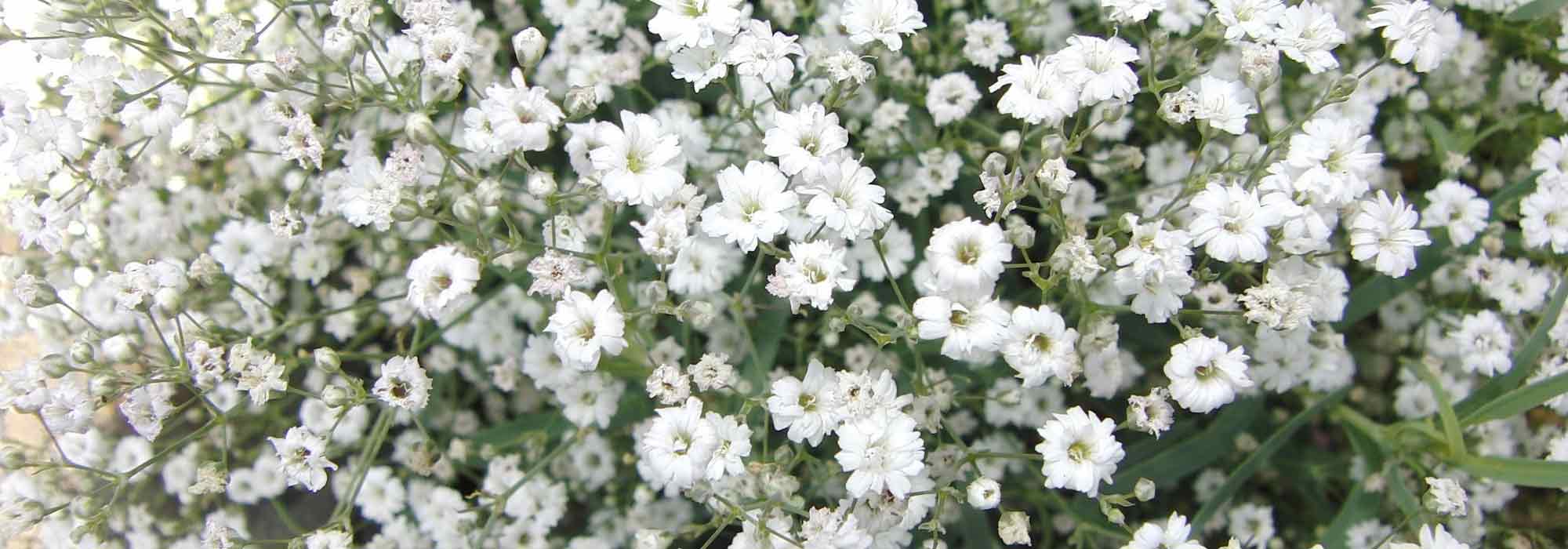
Gypsophila: planting and care
Contents
Gypsophila in a nutshell
- Gypsophila is a lovely airy plant with clouds of white or pink flowers
- Highly floriferous, you will enjoy its abundant flowering from late spring to early autumn
- Perfectly hardy and robust, it requires very little care once well-rooted in the sun, in well-drained limestone soil
- Tall or as groundcover, it will make a strong impression in cottage gardens, wild gardens in borders or rockeries
- It is also particularly valued for adding an airy touch to cut flower arrangements
A word from our expert
The Gypsophila is a lovely perennial or annual plant that offers a profusion of small star-shaped flowers, creating the impression of a cloud of foam or a blanket of mist.
Vaporous clouds of white or pink flowers appear abundantly from June to September. Whether it’s the white Gypsophila or the pink Gypsophila, the tall paniculate Gypsophila, the creeping Repens, or the annual Gypsophila muralis, all are essential for the beautiful season, adding a touch of lightness and delicacy to every garden.
Despite its fragile appearance, Gypsophila is remarkably robust, thriving in calcareous soils and enduring cold down to -15°C in well-drained soil, as well as drought.
Whether tall or groundcover, it integrates into all settings, where it creates an evanescent mist in borders or beds, or a mossy flowering carpet in rockeries. Essential in white gardens and romantic gardens, Gypsophila is also highly valued for adding an airy and refined volume to a wedding bouquet!
Delicate and chic, whether perennial or annual, discover our Gypsophilas, available in pots or seeds, and enjoy their light summer flowering!
Description and Botany
Botanical data
- Latin name Gypsophila
- Family Caryophyllaceae
- Common name Gypsophila
- Flowering from May to September
- Height 0.15 to 1 m
- Exposure Sun
- Soil type All, well-drained
- Hardiness -15°C
The Gypsophila is a herbaceous plant, annual or perennial depending on the species, belonging to the Caryophyllaceae family. It is found in the wild in high-altitude areas, on rocky soils and slopes in southern Europe, particularly in the Iberian Peninsula and Central Asia.
The genus includes over a hundred species and varieties, the most common being Gypsophila paniculata, also known as “baby’s breath”, an upright form reaching 1 m in height, and Gypsophila repens, which has a creeping habit. Both have given rise to hybrids such as ‘Rosenschleier’, ‘Flamingo’, and ‘Rosa Schönheit’.
There is also Gypsophila cerastioides, a gypsophila that develops into a compact cushion, as well as some annual species like Gypsophila muralis, or wall gypsophila, and Gypsophila elegans, perfect for bouquets.
The plant develops from a thick sometimes woody stump consisting of deep but fragile roots. The habit varies by species, taking on the appearance of a bushy shrub or a dense groundcover plant, sometimes even lawn-like.
Gypsophila forms a bushy, rounded clump, highly branched, reaching at least 1 m in all directions or a spreading cushion, not exceeding 10 to 20 cm in height and 40 cm in width when mature.

Gypsophila paniculata – botanical illustration
With a normal to slow growth rate, it can live quite long in very well-drained soil; however, in heavy soil, it will be short-lived and behave as an annual.
The fine and discreet foliage is evergreen to semi-evergreen. The small linear, lanceolate leaves, sometimes fleshy, glabrous or villous, range from 5 mm to 10 cm long and are arranged in opposite pairs on the very fine, highly branched, creeping or ascending stems. They are medium green to slightly bluish green, glaucous.
Gypsophila is remarkable for the poetry and profusion of its flowering, whether creeping or upright. Also known as “baby’s breath” by the English, the bush transforms, from May to September, into a vaporous cloud of numerous small solitary flowers or grouped in large light panicles at the tips of the multiple stems.
Resembling clouds, these tiny star-shaped or trumpet-shaped flowers measuring 0.5 to 2 cm wide form a translucent floral mist that is both aesthetic and extremely light. The groundcover species almost completely disappear under an avalanche of small round flowers.
Simple or double in the form of fluffy pom-poms, they are made up of 4 to 5 petals and come in pastel shades ranging from classic pure white to pale or dark pink, and sometimes in a gradient of candy pink and white.
Delicate, they evoke tiny soft and velvety roses and follow one another throughout the summer.
Cut, these light flower stems are highly sought after by florists for fresh or dried bouquets, to which they add a delicate volume.
Hardy beyond -15°C, drought-resistant and low-maintenance, despite its fragile appearance, Gypsophila is truly an easy plant to grow. From its Mediterranean origins, it has retained a preference for warmth and requires full sun.
Gypsophila does not like humidity. In Greek, its name means that it loves the aridity of calcareous soils: it thrives in light, deep, porous, dry to moist soil, even stony, and especially very well-drained.
The Gypsophila will make a strong impression in wild gardens, dry gardens, rockeries and flowering walls, on sunny slopes where it adds a vaporous relief. It also adapts very well in planters and flowering pots.
Main species and varieties
On distinguishes among the hundred species and varieties of Baby’s Breath, the creeping baby’s breath such as Gypsophila repens and Gypsophila cerastioides, or “cushion baby’s breath”, and the Gypsophila paniculata with an upright habit that can reach up to 1 m in height, forming dense clouds of white or pink flowers that are so recognisable. These two widely spread species of perennial baby’s breath have given rise to some interesting hybrid forms. There are also a few annual species such as Gypsophila muralis and Gypsophila elegans.
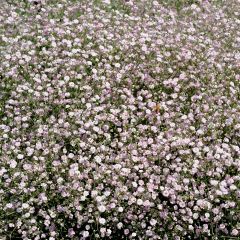
Gypsophila Rosenschleier
- Flowering time July to September
- Height at maturity 50 cm
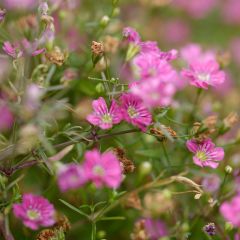
Gypsophila repens Rosa Schönheit
- Flowering time July to September
- Height at maturity 20 cm

Gypsophila paniculata Flamingo
- Flowering time July to September
- Height at maturity 1 m
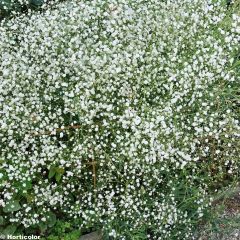
Gypsophila paniculata Bristol Fairy
- Flowering time August to October
- Height at maturity 1,50 m
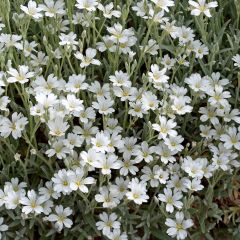
Gypsophila repens Alba
- Flowering time July to September
- Height at maturity 20 cm
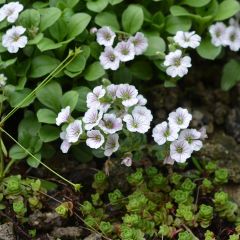
Gypsophila cerastioides
- Flowering time June to August
- Height at maturity 10 cm
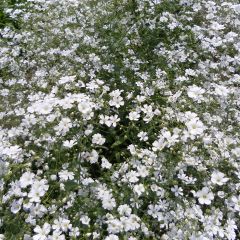
Gypsophila elegans Covent Garden Seeds
- Flowering time July to November
- Height at maturity 45 cm
Discover other Gypsophila
View all →Available in 0 sizes
Available in 3 sizes
Available in 1 sizes
Available in 2 sizes
Available in 1 sizes
Available in 1 sizes
Available in 1 sizes
Available in 2 sizes
Available in 1 sizes
Available in 1 sizes
Planting
Where to Plant Gypsophila
With excellent hardiness, Gypsophila grows well throughout France. It withstands frost and tolerates temperatures as low as at least -15 °C in well-drained soil.
This perennial requires full sun and warm exposures and prefers porous, relatively dry soils. Well adapted to drought, this plant appreciates light, poor, even calcareous soils, especially those that are very well-drained, where it will thrive for many years. It can also tolerate ordinary soil, provided the drainage is perfect.
Gypsophila hates heavy, winter-wet, poorly-drained soils: in waterlogged, compact, clayey soil, it will behave like an annual and die in the winter following its planting.
Provide it with an open situation, as Gypsophila loves space and tends to spread well. It detests root competition: ensure it has plenty of air and especially avoid moving it, as its very fragile roots do not like to be disturbed.
In the middle or at the edge of slightly heavy perennial beds that they lighten, the tall Gypsophila paniculata, which can reach 1 m in height, will add a delicate relief to wild and soft gardens. Groundcover species like Repens can cover large areas and are perfect for rockeries, in the crevices of walls, in scree, and in pots or containers.
All are essential for charmingly and romantically dressing the base of shrubs, especially roses.
When to Plant Gypsophila
Planting Gypsophila is preferably done in spring, between March and April, after the frosts. Autumn planting is also possible, from September to November in mild climates.
How to Plant Gypsophila
In the Ground
Gypsophila fears heavy soils: add river sand or gravel to lighten the soil. It does not like overcrowding and root competition: opt for a well-aerated planting. This is a very airy plant that remains transparent: plant in large clumps for a beautiful effect in a bed or herbaceous border, counting 5 plants per m², spaced at least 40 cm apart for groundcover species and 1 m for the taller species.
- Dig a hole 2 to 3 times the width of the root ball
- Loosen the soil well and remove roots and weeds. Add large stones or gravel to a depth of 20 cm at the bottom of the hole
- Mix river sand or pumice with half of the extracted soil
- Plant without breaking the root ball and fill the hole
- Lightly compact the soil with your foot
- Water regularly during the first summer to encourage rooting
In Pots
While groundcover species like Gypsophila repens are well-suited for pot cultivation, the taller varieties will also thrive in fairly tall pots.
The substrate must be very well-draining to avoid stagnant moisture and root rot. Soil that is too clayey will be detrimental to the hardiness of this undemanding plant: improve drainage with gravel or a mix of stones.
- In a very large pot of at least 50 cm in diameter, spread a good drainage layer
- Plant in a mix of 50% potting soil and 50% coarse river sand or pumice
- Place it in full sun
- Water at planting and then regularly without excess, allowing the soil to dry between waterings
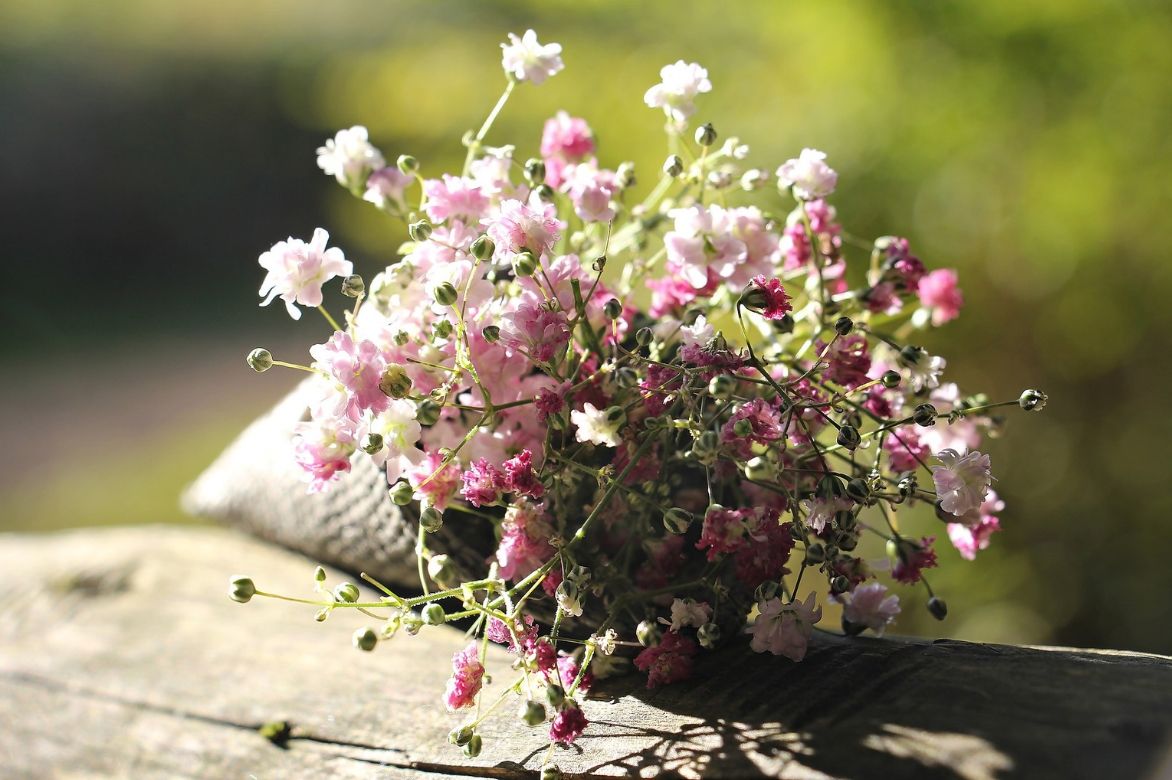
When and how to sow Gypsophila seeds
Sowing concerns the varieties grown as annuals of Gypsophila and is an option if you wish to flower large areas to create a flowering meadow. Sow your Gypsophila seeds directly in early spring between April and May or in trays under cover in autumn for earlier flowering.
In open ground
- Sow by scattering in well-prepared, light, and well-draining soil
- Cover the seeds to a depth of 3 mm
- Thin to about 30 cm apart, more for larger Gypsophila
In trays
- Sow by scattering in a tray or in pots filled with a mix of potting soil and sand
- Cover the seeds with the same mixture
- Lightly firm down
- Keep moist under a cold frame until germination, which occurs in 21 days
- Thin a few seedlings at emergence
- Transplant the seedlings shortly after emergence into small pots
- Plant in the garden when the soil begins to warm up, in May, in light, well-drained soil
Maintenance and Care
Gypsophila requires little maintenance and is not water-hungry. It is perfect for a dry garden and country gardens.
Water regularly during the first summer to encourage establishment. Once well-established in well-draining soil, it will become increasingly resistant to drought and will only require watering in cases of prolonged drought. In pots: always allow the soil to dry out completely between waterings.
It is an undemanding plant that thrives in poor soils and does not require fertiliser.
Weed regularly around its base and provide a mineral mulch of gravel to save yourself this chore.
Support tall gypsophilas with brittle stems or place them at the base of roses for support. If necessary, tie up the tall stems.
Remove faded flower heads as they occur.
Creeping varieties of gypsophila do not require pruning: simply remove damaged stems if necessary.
Cut back the dry stems of the larger species after flowering.
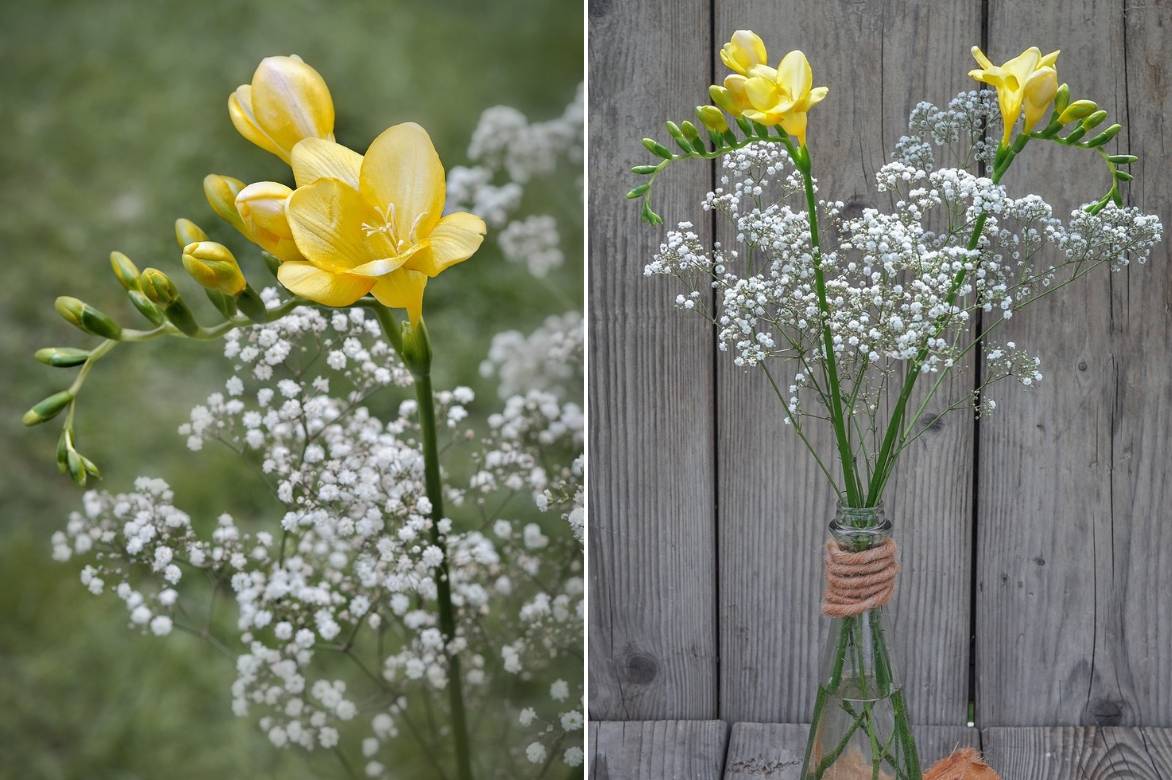
Bouquet of Freesia and Gypsophila paniculata ‘Bristol Fairy’
Diseases and potential pests
Planted in well-drained soil, Gypsophila shows a good resistance to diseases. It truly fears only two things: excess moisture and gastropods at the start of the growing season.
Excess water in the soil encourages the appearance of fungal diseases leading to the rotting of stems or the collar: a well-drained soil will prevent the development of fungi.
If the young plants are devoured by slugs and snails: follow all our tips to combat these gastropods!
Multiplication: propagation by cuttings
Once well-rooted, Gypsophila does not like to be disturbed; we advise against division as the risk of damaging the root is considerable. Moreover, Gypsophila is very easy to sow. Root cuttings are possible.
How to Take a Gypsophila Cutting
- In spring, take offsets from the edge of the clump
- Trim these fleshy root pieces at the base
- Insert them into a bed of gravel in a mixture of turf and river sand
- Water occasionally
- Repot into a larger pot and plant in the ground the following spring
- Transplant when the cutting has sufficient roots
→ Discover Angélique’s tutorial on the propagation of Gypsophila
Associate gypsophila with the garden
The white or pink vapourous clouds of Gypsophila are perfect for playing with shades and gradients, softening intense hues. With its slender silhouette, delicate and light foliage, and pastel inflorescences, it transforms a simple perennial bed, a blurred rockery, or an ordinary mixed border into a poetic tableau.
It is a perfect plant for filling gaps and ensuring continuity of flowering.
It is the ideal companion for old or modern roses or shrub peonies, which it dresses at the base, composing romantic summer scenes with them. It adds charm to cottage gardens and country gardens, bringing volume, delicacy, and lightness. It is a must-have in white gardens and pink gardens.
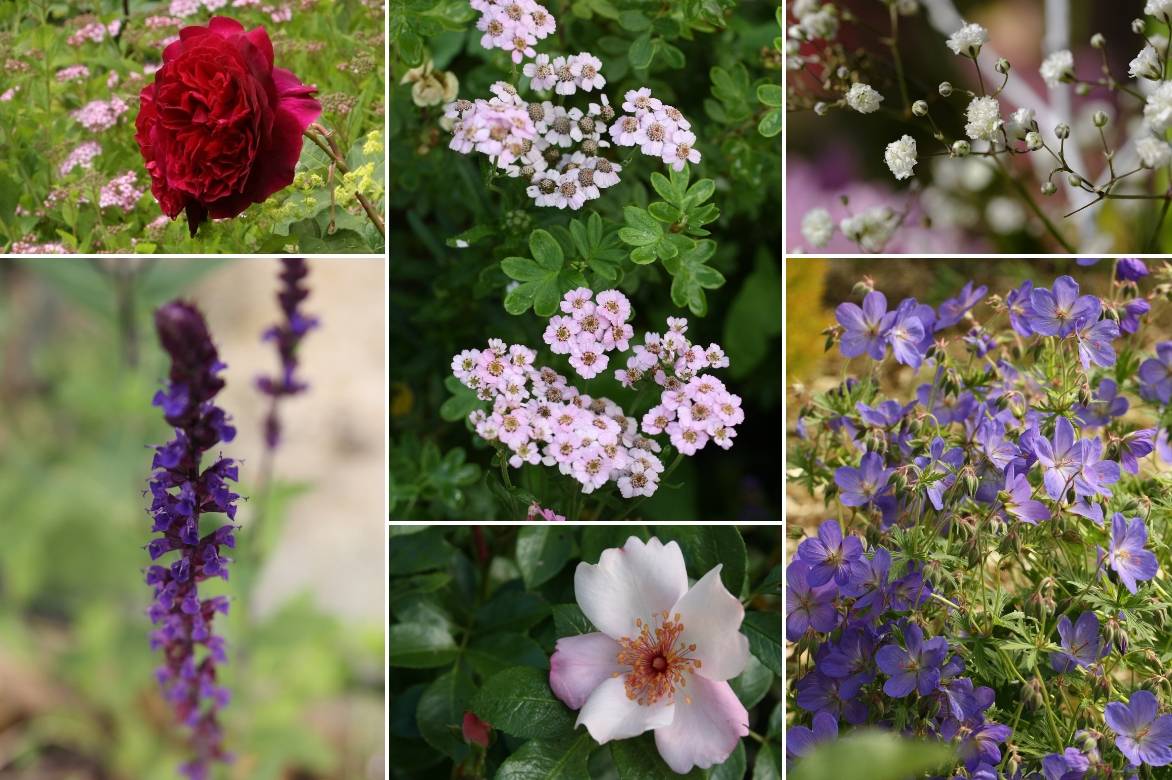
An example of pairing: Rose ‘Munstead Wood’, Salvia nemorosa ‘Caradonna’, Achillea ‘Love Parade’, Rose ‘Astronomia’, Gypsophila paniculata ‘Bristol Fairy’, Geranium ‘Johnson’s Blue’
It enhances the deep pink, carmine, or crimson flowers of Garden Poppies, carnations, or sage, as well as the glaucous foliage of Achilleas millefolium, spurge, or even lavender.
Its extraordinary lightness makes it suitable for beds of heavier or large-flowered perennials, such as oriental poppies, garden irises, echinaceas, phloxes, Verbascums, Hesperis matronalis, or thistles.
In graceful compositions full of finesse, pair it with Cosmos, gaura, delicate asters, or airy Thalictrums that it accompanies during flowering.
In window boxes, it will accompany sedums, pelargoniums, and petunias.
→ Discover more pairing ideas with Gypsophila in our advice sheet.
Useful resources
- Elegant and chic, Gypsophila stands out in a white garden
- With its pastel shades, Gypsophila is essential in a romantic border; discover its companion plants!
- Its slightly blurred appearance and ease of maintenance make Gypsophila indispensable in country gardens
- It’s a lovely solution to dress the base of your roses
- Some tips for growing Gypsophila in pots
- Also read our advice sheet on The best long-lasting flowers and foliage for your bouquets
- Discover the qualities of different varieties of Gypsophila!
- Subscribe!
- Contents
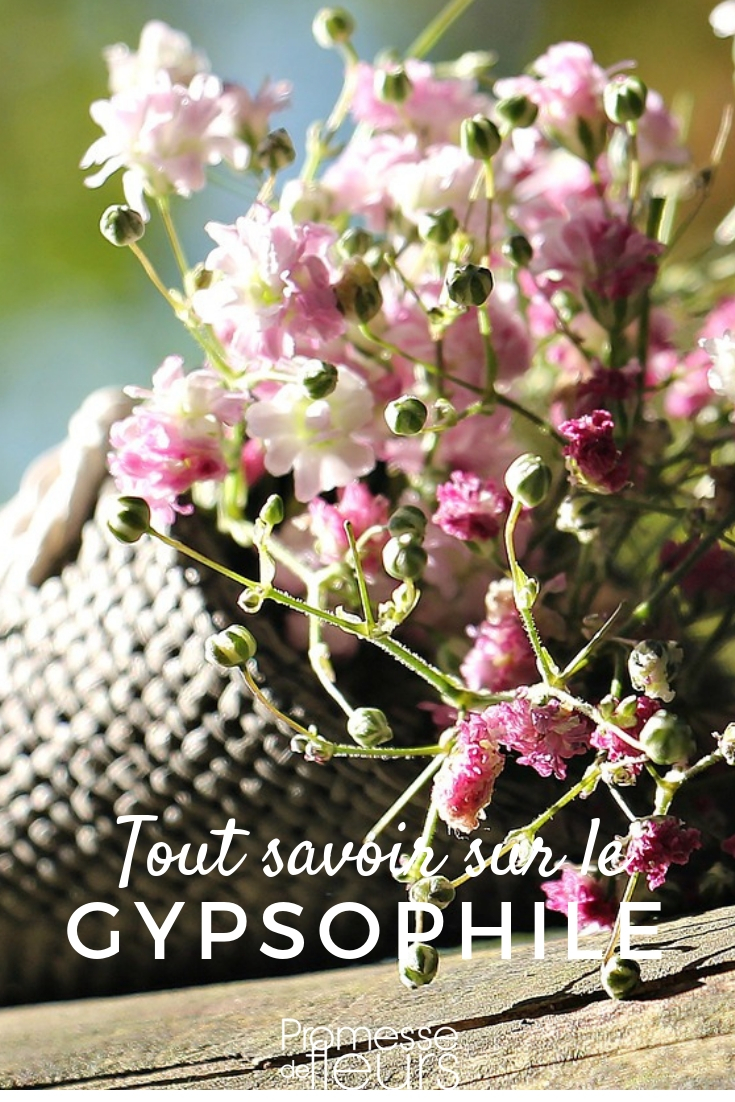






























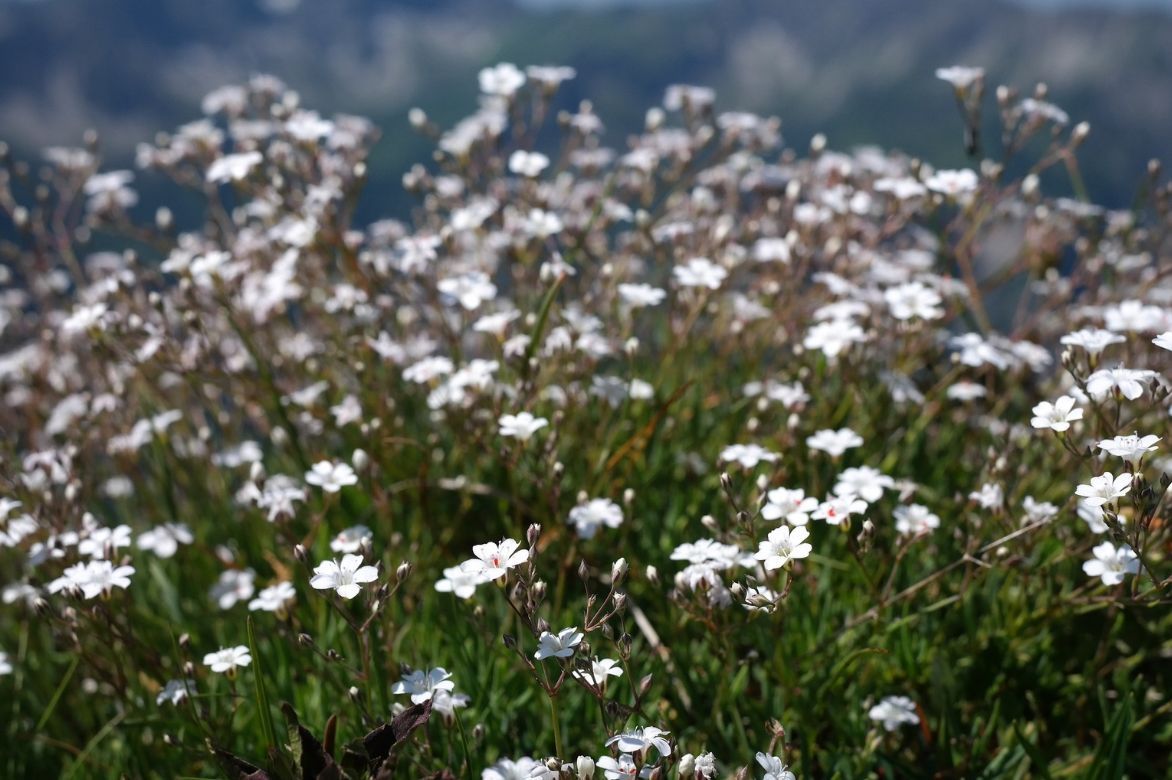


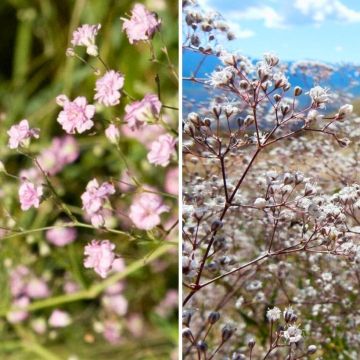

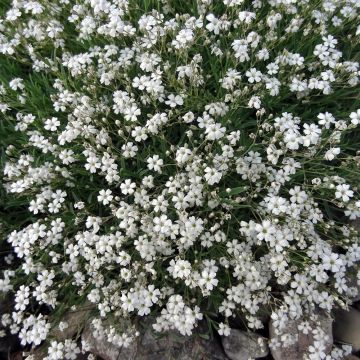

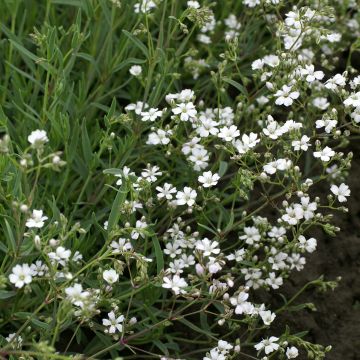
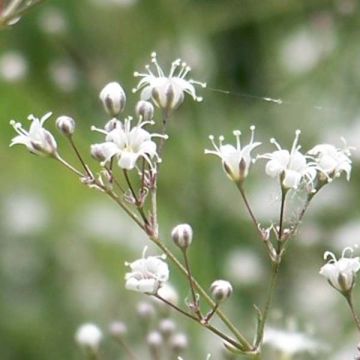
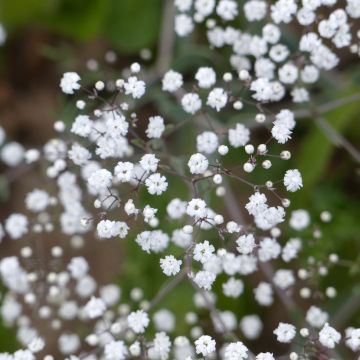

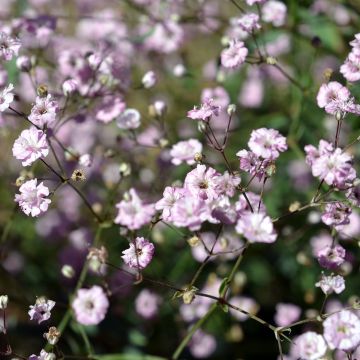
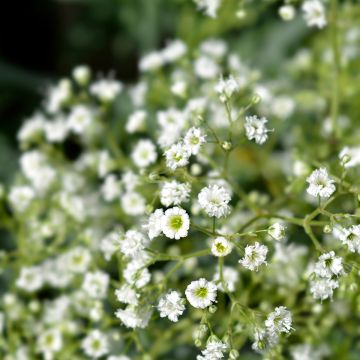
Comments